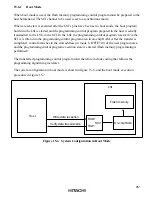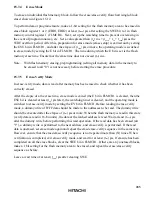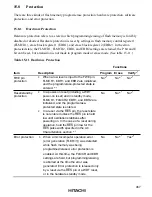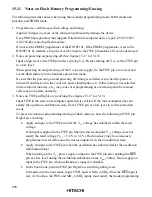
464
Start
End of programming
End of Subroutine
Set SWE bit in FLMCR1
Wait (t
sswe
)
µ
s
n = 1
m = 0
Sub-routine-call
Sub-routine-call
See Note 6 for pulse width
Note 6: Write Pulse Width
Start of programming
Write Pulse subroutine
Set PSU bit in FLMCR1
Enable WDT
Set P bit in FLMCR1
Wait (t
spsu
)
µ
s
Clear P bit in FLMCR1
Wait (t
sp
30 or t
sp
200)
µ
s
Clear PSU bit in FLMCR1
Wait (t
cp
)
µ
s
Disable WDT
Wait (t
cpsu
)
µ
s
Write pulse application subroutine
No
No
No
No
No
No
Yes
Yes
Yes
Yes
Yes
Wait (t
spv
)
µ
s
Wait (t
spvr
)
µ
s
*
2
*
4
*
7
*
7
*
7
*
7
*
7
*
7
*
1
*
5,
*
7
*
7
*
7
*
7
*
1
Write Pulse (Additional programming)
Set PV bit in FLMCR1
H'FF dummy write to verify address
Read verify data
Program data =
verify data?
6
≥
n?
6
≥
n?
*
4
*
4
*
3
Additional-programming data computation
Wait (t
cswe
)
µ
s
m = 1
128-byte data
verification completed?
m = 0?
Increment
address
Programming failure
Yes
Wait (t
cswe
)
µ
s
Clear SWE bit in FLMCR1
Clear SWE bit in FLMCR1
n
≥
(N)?
Reprogram Data
(X')
0
0
0
0
1
1
1
0
1
1
1
1
Verify Data
(V)
Additional-Programming
Data (Y)
Comments
Additional programming to be executed
Additional programming not to be executed
Additional programming not to be executed
Additional programming not to be executed
Successively write 128-byte reprogram
data area in RAM to flash memory
Write Pulse (Write pulse)
RAM
Program data storage
area (128 bytes)
Reprogram data storage
area (128 bytes)
Additional-programming data
storage area (128 bytes)
Store 128 bytes of program data in program
data area and reprogram data area
Programming Count (n)
1
2
3
4
5
6
7
8
9
10
11
12
13
.
.
.
998
999
1000
Programming Time (z)
µ
sec
t
sp
30
t
sp
30
t
sp
30
t
sp
30
t
sp
30
t
sp
30
t
sp
200
t
sp
200
t
sp
200
t
sp
200
t
sp
200
t
sp
200
t
sp
200
.
.
.
t
sp
200
t
sp
200
t
sp
200
Original Data
(D)
Verify Data
(V)
0
1
0
1
0
0
Reprogram Data
(X)
Comments
Programming completed
Programming incomplete:
reprogramming to be executed
Reprogram Data Computation Table
0
1
1
—
1
1
1
Still in erased state: no action
Additional-Programming Data Computation Table
Transfer additional-programming data
to additional-programming data area
Reprogram data computation
Clear PV bit in FLMCR1
Wait (t
cpv
)
µ
s
Transfer reprogram data to reprogram
data area
Successively write 128-byte data from
additional-programming data area
in RAM to flash memory
n
←
n + 1
Note:
Use a 10
µ
s write pulse for additional programming.
Notes: 1. Data transfer is performed by byte transfer. The lower 8 bits of
the first address written to must be H'00 or H'80. A 128-byte data
transfer must be performed even if writing fewer than 128 bytes;
in this case, H'FF data must be written to the extra addresses.
2. Verify data is read in 16-bit (word) units.
3. Reprogram data is determined by the operation shown in the
table below (comparing the data stored in the program data area
with the verify data). For reprogram data 0 bits, programming is
executed in the next reprogramming loop. Therefore, even bits
for which programming has been completed in the 128-byte
programming loop will be subject to programming again if they
fail the subsequent verify operation.
4. A 128-byte area for storing program data, a 128-byte area for
storing reprogram data, and a 128-byte area for storing
additional-programming data must be provided in RAM. The
reprogram and additional-programming data contents are
modified as programming proceeds.
5. A write pulse of 30
µ
s or 200
µ
s is applied according to the
progress of the programming operation. See Note 6 for details of
the pulse widths. When writing of additional-programming data is
executed, a 10
µ
s write pulse should be applied. Reprogram data X' means reprogram data when the write pulse is applied.
7. The wait times and the value of N are shown in table 18-15, Flash Memory Characteristics.
Programming must be executed
in the erased state. Do not
perform additional programming
on addresses that have already
been programmed.
Reprogram
Figure 15-11 H8/3022F Program/Program-Verify Flowchart
















































